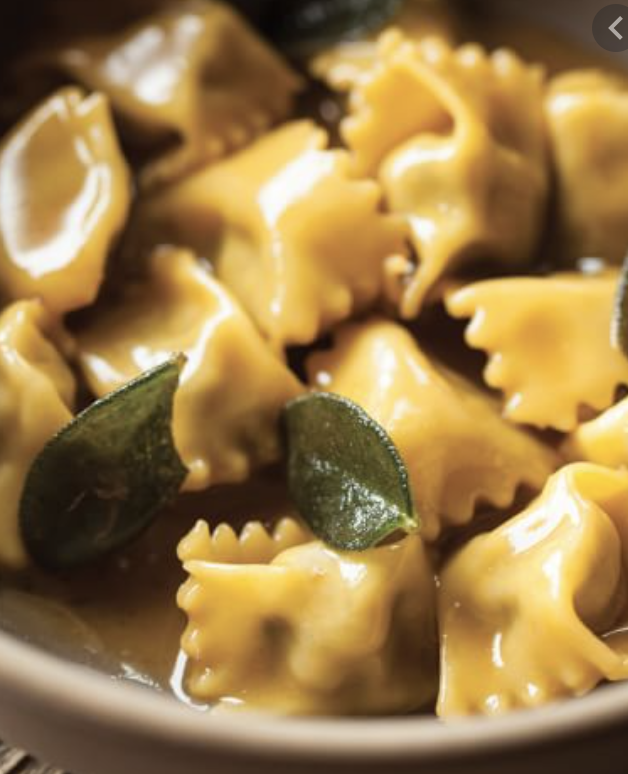Ingredients
-
9 ounces of meat (chicken, pork, beef, or any combo) cut in 1 inch cubes (255 grams)
-
kosher salt
-
2 tablespoons neutral oil, like canola, grapeseed, or vegetable oil
-
2 tablespoons pure olive oil
-
1 small onion (90 grams), diced
-
½ cup (120 ml) red wine
-
2 cups loosely packed spinach, coarsely chopped
-
¼ teaspoon sherry vinegar
-
1 large egg
-
¾ cup freshly grated Parmigiano-Reggiano cheese
-
1½ teaspoons grated nutmeg
-
freshly ground black pepper
-
butter sage sauce
-
1 cup (250ml) chicken stock
-
8 tablespoons (125 grams) unsalted butter
-
4-8 whole sage leaves
-
finish
-
freshy grated Parmigiano-Reggiano cheese
-
special equipment
-
large ruler or tape measure
-
pasta maker, hand crank or electric
-
pizza cutter, or fluted pastry cutter
-
dough/bench scraper
-
spray bottle with water (optional but ideal)
-
pastry bag or large zip loc bag
Directions
|
1
Done
|
meatIn a large bowl mix together the meat and season with a few pinches of salt. Let sit for about 30 minutes. |
|
2
Done
|
Heat the canola oil in a medium size (about 12 inches/30cm) sauté pan over high heat. Once hot, add the seasoned meat and cook, stirring occasionally, until the meat is caramelized and deeply browned, about 5 minutes. |
|
3
Done
|
Remove the meat to a plate and set aside. |
|
4
Done
|
In the same pan over high heat, add the olive oil and the onion. Cook for about 4 minutes, scraping the bottom of the pan with a wooden spoon to release the fond (the caramelized meat on the bottom of the pan) until the onions are well caramelized, about 10 minutes. |
|
5
Done
|
Add the red wine and cook until the pan is almost dry, 1 to 2 minutes. Add the spinach and cook until just wilted, about 1 minute. Remove the vegetables to a bowl and set aside until completely cool. |
|
6
Done
|
Combine the onion mixture with the browned meat in a bowl and stir until well incorporated. |
|
7
Done
|
Use a food processor to grind it to a smooth texture or chop it as finely as you can by hand. |
|
8
Done
|
Once the meat is ground, add the vinegar, egg, Parmigiano-Reggiano and nutmeg and season with black pepper and salt. Mix well. |
|
9
Done
|
Finito! Ready for the ravioli! |
|
10
Done
|
making ravioliThe dough is rolled out until the second to last setting. |
|
11
Done
|
Take sheets and with a straight wheel pasta cutter or knife, cut the sheet of dough half lengthwise, forming two strips that are about 3 inches wide. Use your tape measure or ruler. |
|
12
Done
|
|
|
13
Done
|
Take edge closest to you and fold over, away from you, to comfortably cover the filling but still leaving about 1/4 inch dough bare on the far edge. Use a spritz of water, or dab finger in little dish of water to seal. |
|
14
Done
|
|
|
15
Done
|
Once pinch is created, seal each agnolotti be gently pressing the rest of the dough over filling and removing any air pockets. |
|
16
Done
|
Trim the entire edge directly in front of filling, with a fluted or straight cutter. Now using cutter, cut between each filling. The "pocket" will be formed with each cut. Place on baking sheets dusted with semolina or flour, and do not let them touch. Repeat with other pieces of dough/filling, you will have about 75 agnolotti if all goes well. |
|
17
Done
|
sauceIn a large saute pan add the chicken stock, butter, and sage leaves. Turn heat to high and then bring to a simmer. Remove from heat until ready to use. Place on medium heat when ready to add agnolotti to this sauce bringing up temperature to be hot but do not burn. |
|
18
Done
|
cooking agnolottiBring at least 4 quarts of water to a boil, add about 1/4 cup kosher salt (optional: handful of semolina flour, or the remains of flour from making the ravioli). |
|
19
Done
|
Add the agnolotti and cook, about 2 minutes until al dente (slight chewy to the bite). |
|
20
Done
|
Add the agnolotti to the butter sage pan stir to coat the sauce onto the agnolotti. |
|
21
Done
|
to serveScoop into individual plates or one large bowl and sprinkle with a generous amount of Parmigiano-Reggiano. |











